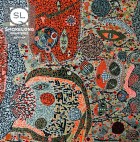I was fascinated by the recurrence of ghosts, haunting, and memory in this piece. Can you talk about what these themes are doing in the story and what you want your readers to take away?
It just came out that way. This piece was an opportunity to explore my own past and the town I grew up in. The idea of ghosts for me is what’s left over on the other side of change. This story is about the memory of who we once were and what we’ve lost along the way. It’s a nod to how the past haunts us.
As far as my readers … I hope that there’s a sense of intimacy that comes across. This one feels so much more personal to me than my other stories. But beyond that, I invite them to take what they will from it.
The title of this story has an instructive quality (“how to leave them”) and your story is written in eight parts. Can you talk about your decision to structure the piece this way and how you conceived of the title?
Structurally speaking, I wanted a clear pause between sections. I think to read this piece as a connected string of paragraphs would water down the experience. Breaking into sections was a way to let the white space help pace the story. I wanted each bite tasted and swallowed on its own terms before the reader moves on to the next. Each paragraph deserved the respect of a numbered section. They warranted the formality.
The title came after the piece was polished up. The instructive element played well with the structure, and is a reflection of the speaker’s plight to understand the nature of change and loss. The piece ends with the speaker recalling driving through the desert before some of the key events. He hasn’t left his desert town behind. His memory is drawn to a moment in which things are likely how he would have wanted things to stay. When he acknowledges being able to see ghosts, it’s a sort of acceptance. He’s moving on but with his ghosts in tow.
How does “On Desert Towns and How to Leave Them” speak to your own personal and writerly questions? How is it building on or breaking from your previous work?
All of my short fiction is set in the same desert town, for better or worse. But this piece breaks from my usual writing. My stories tend to be very tangible, minimal, and understated. That and I don’t typically write flash fiction. With this piece, I got out of the way. With the brevity of the form, it worked nicely to be a little more indulgent. I could write about ghosts and smelling the stink of prayers and it didn’t feel like too much. I could invite the reader into the place itself. Really invite them in. It all felt so much more personal, once it was all done.
You’ve also written a post-apocalyptic children’s series—tell us more about this!
I’ve got three young children and I love the post-apocalyptic genre. At some point, I became fascinated with the idea of parenting in that reality. How would you teach your kids? How would you explain depravity, the threat of violence, the importance of staying hidden? The “My Name Is Fall” series was a chance to tell a story completely appropriate for children, but that would simultaneously have some of the more mature themes lurking in the background.
At about the same time that I started writing the books, I had become fascinated by crowdfunding. I used to follow board games on Kickstarter. I loved the community and I saw an opportunity to self-publish.
We’re two books in with the third scheduled for next year (and I’ve loved every moment of the process).
What are the books or stories that inspire you, that you find yourself coming back to over and over?
Anything written by Cormac McCarthy. His books have stayed with me more than any others I’ve read in the past ten years. I don’t care for his lack of quotation marks, but that aside, I think his books are wonderful and terrifying examinations of human nature and a master class on antagonists.



 The core workshop of SmokeLong Fitness is all in writing, so you can take part from anywhere at anytime. We are excited about creating a supportive, consistent and structured environment for flash writers to work on their craft in a community. We are thrilled and proud to say that our workshop participants have won, placed, or been listed in every major flash competition. Community works.
The core workshop of SmokeLong Fitness is all in writing, so you can take part from anywhere at anytime. We are excited about creating a supportive, consistent and structured environment for flash writers to work on their craft in a community. We are thrilled and proud to say that our workshop participants have won, placed, or been listed in every major flash competition. Community works.